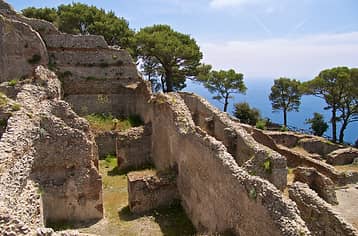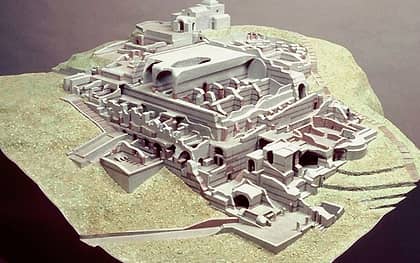Villa Jovis





Visiting Villa Jovis
Villa Jovis is situated at the end of Viale Amedeo Maturi, where one finds a number of steps faced with marble slabs originating from the Roman Villa. Villa Jovis, built in the first century B.C. and attributed to Tiberius, was chosen for its position on the cliff's edge which guaranteed both privacy and security, of vital importance to the Emperor.
Getting there: From the Piazzetta, walk the length of Via Longano, continuing along Via Sopramonte and finally Via Tiberio. It's an uphill walk and will take about 45 minutes.
Ticket price: Euro 6,00; free for European Union citizens under 18. Tickets can only be paid by credit card and debit card.
Current opening & Hours:
January and February
Closed
March
10 am - 4 pm
April
10 am - 5 pm
May
10 am - 5 pm
June to September
10 am to 5 pm
October
10 am to 5 pm (from 1st to 15th), 10 am to 4 pm (from 16th to 31st)
November and December
10 am to 4 pm
Last entrance: 30 minutes prior to closing time
Closed on Mondays
A considerable percentage of the Roman villa remains, a villa which was built with large cisterns and water tanks, so as to counteract the perennial lack of water on the island of Capri. Villa Jovis was organized in sections linked by corridors, stairs and passageways. The Emperor had a North facing apartment with views over the Gulf of Naples; to the East there was the section dedicated to official functions; the baths were to the South and to the West the servants accommodation and lavatories were located. Tiberius's Villa extended over 5.500 square meters and was built up on various levels, unusual for the period, but made necessary by the location.
At the end of the avenue which leads to the villa there is the famous "Tiberius's Leap", place where, according to local legend, disobedient servants and undesired guests were hurled over the cliff by order of the Emperor. The furnishings and decorative features have been gradually removed over the centuries; placed in museums or used to decorate Royal palazzo, with some materials, such as the marble paving, even sold by weight.
The Villa Jovis complex was officially inaugurated in 1937, after excavation work carried out by the Archaeologist Amadeo Maiuri following strict scientific criteria. Within the site boundaries of Villa Jovis one finds the small Church of Santa Maria del Soccorso. In the space in front of the church there is a statue of the Madonna, visible from the sea below.
The simplest route to Villa Jovis
From Piazza Umberto I (Piazzetta di Capri) take Via Le Botteghe, followed
by Via Fuorlovado, Via Croce and Via Tiberio.
Combine Parco Astarita and Villa Lysis
An insider tip! The route to Villa Jovis takes a bit of time and effort, so it's nice to break it up by adding two stops along the route: Parco Astarita and Villa Lysis. This way you can make the most of your time and avoid getting too tired out along the walk.
Before entering Villa Jovis, take a moment to wander through the beautiful but little-known Parco Astarita, which is free to the public. It's worth the stop if only to take in the view from the final terrace of the park, which is truly breathtaking. You will also run into the wild goats which roam free on Capri's hillsides during your walk.
Afterwards, stop at the lovely Villa Lysis, the historic residence built by Count Fersen during his exile on Capri.
Top Hiking and Walking Trails in Capri.
Information
The opening hours of Villa Jovis, Parco Astarita and Villa Lysis change frequently, so before you plan on visiting, we suggest double-checking to make sure it’s open by asking at the tourist information offices in the Piazzetta or Marina Grande'''.





FAQ - Frequently asked questions
How can you get to Villa Jovis from Capri town center?
From Piazzetta di Capri, walk along Via Longano and then Via Tiberio, about 2 km uphill. The walk takes around 35–40 minutes and is clearly marked. Private vehicles are not allowed.
Quanto tempo serve per visitare Villa Jovis?
Visiting Villa Jovis takes about 1 hour, though many travelers stay longer to enjoy the view over the Bay of Naples. The walk there is part of the experience, so plan for about 2 hours total, including the round trip. Comfortable shoes are a must.
Is Villa Jovis accessible for visitors with reduced mobility?
Unfortunately, no. The road to Villa Jovis is steep and includes uneven steps, making it inaccessible for wheelchairs or strollers. Those with mobility issues can still enjoy the view from Via Tiberio or visit more accessible sites like Villa Lysis.
Can you reach Villa Jovis by taxi or scooter?
No, private traffic is restricted in the Tiberio area. Taxis and scooters can only go as far as Capri town center. From there, the rest of the route must be done on foot.
Do you need to book your visit in advance?
No reservation is needed — entry to Villa Jovis is always guaranteed during opening hours. Tickets are purchased directly at the entrance, even during peak season.
Are there any facilities or cafes near Villa Jovis?
There are no cafes or facilities inside the archaeological site. However, along Via Tiberio, you’ll find small kiosks and restaurants for refreshments. It’s smart to bring a water bottle and a hat to protect yourself from the sun.
What can you see inside Villa Jovis?
You’ll find the ruins of Emperor Tiberius’s imperial palace, including cisterns, ceremonial rooms, and a stunning viewpoint. From here, the emperor could overlook the entire Bay of Naples. The area is well marked with information boards and scenic walking paths.
Are there public restrooms at Villa Jovis?
There are no public restrooms inside the site. It’s best to use facilities before starting the walk from Capri town.
Can you visit Villa Jovis in the rain?
Yes, but the path can get slippery and views may be limited. In case of storms, access might be temporarily closed for safety. It’s smart to check the local weather forecast and wear shoes with good grip.
Are guided tours available for Villa Jovis?
Yes, several local agencies and guides offer small-group tours, often combined with Villa Lysis or scenic trails. The average duration is 2–3 hours. The commentary provides insight into Tiberius’s history and Roman architectural techniques.